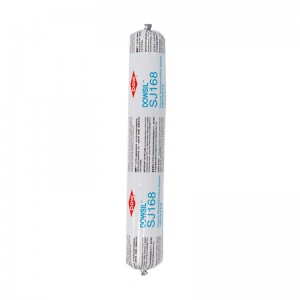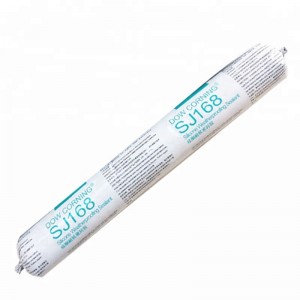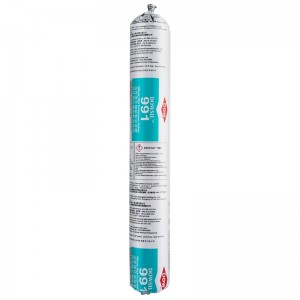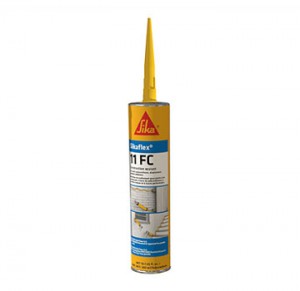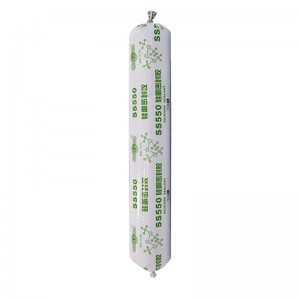DOWSIL™ SJ-168 Silicone Weatherproofing Sealant
Features &Benefits
Here are some key features and benefits of DOWSIL™ SJ-168 Silicone Weatherproofing Sealant:
Weatherproofing: It provides excellent resistance to extreme weather conditions, including UV radiation, temperature changes, and moisture, making it ideal for use in outdoor applications.
Durability: This sealant has excellent resistance to aging, cracking, and discoloration, ensuring long-lasting performance and a clean appearance.
Easy to use: It is a one-part sealant, which means it does not require any mixing or special equipment for application. It can be easily applied using a standard caulking gun.
Adhesion: This sealant has excellent adhesion to most common substrates, including glass, aluminum, concrete, and painted surfaces, making it a versatile option for a wide range of applications.
Range of colors: It is available in a range of colors, including clear, white, black, gray, and bronze, to match different substrates and aesthetic requirements.
Low VOC: This sealant has low VOC emissions, which means it meets environmental and regulatory requirements for air quality.
Applications
Exterior wall joints: These can be used to seal gaps and joints in exterior walls, including between different building materials, such as concrete and aluminum.
Window and door perimeters: This sealant can be used to seal the perimeters of windows and doors, providing protection against air and water infiltration.
Curtain walls: It is suitable for sealing and weatherproofing curtain walls, including metal and glass assemblies.
Roofing: This sealant can be used to seal gaps and joints in roofing applications, providing protection against moisture and air infiltration.
HVAC systems: It is suitable for sealing gaps and joints in HVAC systems, providing protection against air leakage and improving energy efficiency.
Masonry and concrete: This sealant can be used to seal gaps and joints in masonry and concrete applications, providing protection against moisture and air infiltration.
Transportation: DOWSIL™ SJ-168 can be used in transportation applications, including sealing and weatherproofing around windows and doors, and protecting against vibration and noise.
DESIGN OF WEATHERPROOF JOINT
To ensure optimal performance, it is important to design weatherproof joints properly when using DOWSIL™ SJ-168 Silicone Weatherproofing Sealant. Here are some general guidelines for designing weatherproof joints with this sealant:
Joint design: The joint should be designed to accommodate the expected movement and be of the appropriate size and shape. The recommended joint width-to-depth ratio is 2:1.
Substrate preparation: The joint surfaces should be clean and free of any contaminants that could affect the adhesion of the sealant. The surfaces should be dry, and the temperature of the substrate should be above the dew point.
Primer: For improved adhesion, a suitable primer may be required for specific substrates, such as painted or anodized aluminum.
Backer rod: For larger joints, a backer rod should be used to control the depth and provide support for the sealant. The backer rod should be the correct size and shape to avoid over-compression or underfilling of the joint.
Application: The sealant should be applied with a suitable caulking gun, ensuring that the sealant fills the joint completely without voids. A smooth and uniform surface can be achieved using a suitable tool, such as a spatula or a smoothing blade.
Curing: The curing time of DOWSIL™ SJ-168 Silicone Weatherproofing Sealant will depend on the temperature, humidity, and depth of the joint. It is recommended to wait until the sealant has fully cured before exposing it to rain or other moisture.
HOW TO USE Surface cleaning
Proper surface cleaning is an important step in preparing the substrate for the application of DOWSIL™ SJ-168 Silicone Weatherproofing Sealant. Here are the steps to clean the surface:
Remove all loose material, such as dirt, dust, and debris, from the surface of the joint using a stiff bristle brush or compressed air. Pay special attention to corners and crevices where debris can accumulate.
Clean the surface with a non-abrasive cleaner, such as a mild soap and water solution, to remove any dirt, oil, or other contaminants. Avoid using cleaners that contain abrasive particles, solvents, or acids, which can damage the substrate.
Rinse the surface thoroughly with clean water to remove any residue from the cleaning solution. Allow the surface to dry completely before proceeding with the application of the sealant.
If a primer is required, apply the primer to the surface according to the manufacturer's instructions. Allow the primer to dry completely before applying the sealant.
It is important to note that the cleaning process may vary depending on the substrate and the level of contamination. Always refer to the manufacturer's instructions for specific cleaning and preparation guidelines
LIMITATIONS
DOWSIL™ SJ-168 Silicone Weatherproofing Sealant has some limitations that should be taken into consideration to ensure optimal performance:
Do not use in submerged applications or in contact with fuels, solvents, or chemicals.
Do not apply to damp or wet surfaces, as this can affect adhesion and cure time.
Do not apply when the temperature of the substrate is below 5°C (41°F) or above 40°C (104°F).
Do not apply to substrates that are frost-covered, damp, or contaminated with oil, grease, or other substances that can affect adhesion.
Do not apply in areas where movement exceeds the limits specified by the manufacturer.
Do not use on surfaces that are continuously exposed to water or immersed in water, as prolonged exposure to water may cause discoloration and loss of adhesion.
Do not use as a glazing sealant or in structural applications.
Avoid exposure to ultraviolet (UV) light, as prolonged exposure can cause discoloration and degradation of the sealant.




